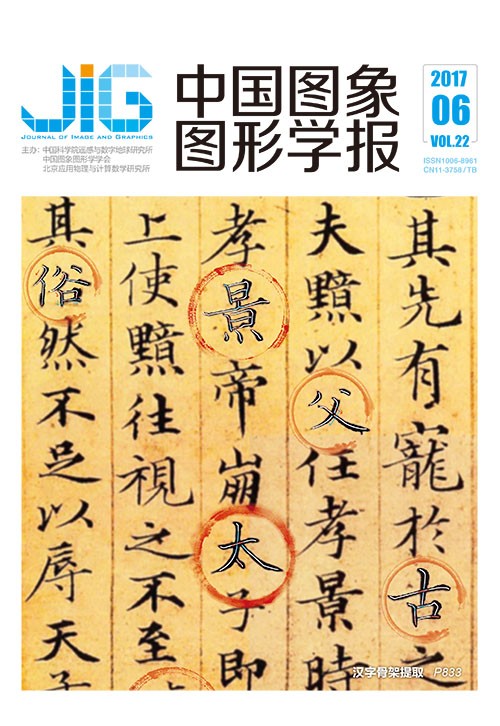
修正大气耗散函数的单幅图像去雾
摘 要
目的 针对暗原色先验原理对雾霾图像中天空或白色物体等明亮区域透射率估计不足,导致该区域去雾后彩色失真的问题,提出一种基于暗原色先验和引导滤波修正大气耗散函数的单幅图像去雾算法。方法 首先,基于暗原色先验模型得到大气耗散函数的粗估计值;其次,构造一个修正函数,纠正暗先验失效的明亮区域的大气耗散函数;然后,对修正后的大气耗散函数和求得的初始传输图分别利用引导滤波进行优化,平滑图像边缘的同时保持图像细节信息;最后,由优化后的传输图和估计的大气光值得到复原图像。结果 选取多幅经典图像进行对比实验,并利用峰值信噪比和均方误差衡量去雾结果的失真程度。实验结果表明,本文算法不但在非明亮区域可以得到较好的去雾效果,而且也能使图像中的明亮区域保持原有色彩,相比而言本文算法得到的复原图像整体失真较少;对于大小为460×;300像素的图像,本文算法与He方法相比,得到的复原图像峰值信噪比提高了0.6005 dB,均方误差降低了0.0026,耗时缩短了29.6220 s。结论 对于雾天包含明亮区域的降质图像,提出了一种修正大气耗散函数的单幅图像去雾算法。实验结果的主观和客观评价表明本文算法对天空或白色物体等明亮区域能得到较好的去雾效果,有效改善了暗原色先验原理对图像中明亮区域造成的彩色失真问题。
关键词
Single-image dehazing algorithm to correct atmosphere veil
Chen Dandan1, Chen Li1, Zhang Yongxin1,2, Yan Han1(1.School of Information and Technology, Northwest University, Xi'an 710127, China;2.Central Plains Economic Zone wisdom Tourism Cooperative Innovation Center in Henan Province, Luoyang Normal University, Luoyang 471934, China) Abstract
Objective Haze is a common natural phenomenon formed by suspended particles in the atmosphere (e.g., water droplets and dust). In foggy weather, images obtained outdoors lose contrast and exhibit color distortion. Therefore, these images are difficult to utilize in computer vision applications, such as object detection and target tracking. One of the reasons images captured outdoors exhibit the above mentioned problems is that the reflected light received by the camera is attenuated. Another reason is that the irradiance from these objects blends with the atmospheric light scattered by particles. Therefore, effective methods must be used to remove haze. Single-image haze removal has exhibited remarkable progress recently. Dark channel prior is one of the valid methods of haze removal. Most images applied with dark channel prior produce good results. However, the dark channel prior method uses a soft matting to refine transmission maps, thus increasing the complexity of the algorithm. The guided filter is used to optimize transmission maps in dark channel prior. However, dark channel prior may still lead to the problem of cross color because the estimated transmission of the sky or bright-object regions in a hazy image is undervalued. Similarly, most existing methods of image dehazing cannot deal with this problem well. To resolve this deficiency, a method is proposed in this study to remove haze from an image through dark channel prior and a guided filter.Method First, with the model of dark channel prior, a coarse estimate of atmosphere veil is obtained. Second, the atmosphere veil containing sky or bright-object regions of the hazy image is corrected by introducing a correction function because dark channel prior is inapplicable to bright regions. Third, to smooth the edge and retain the detail information of the image, a guided filter is utilized to optimize the coarse atmosphere veil. The initial transmission map is obtained from the optimized atmosphere veil and optimized by the guided filter. Finally, the optimized transmission map and the estimated atmospheric light are used to obtain the restored image.Result To demonstrate the effectiveness of the proposed method, several classic images are used to conduct experiments. Peak signal-to-noise ratio (PSNR) and mean squared error (MSE) are adopted to measure the degree of distortion of the experimental results. The experimental results show that the haze-free image recovered with the proposed method produces a better result for non-bright regions and retains the original color of bright-object regions compared with Tarel's method, He's method, Meng's method, and Jiang's method. In general, the proposed method presents minimum distortion. Compared with He's method, the PSNR of the proposed method is increased by 0.600 5 dB, MSE is reduced by 0.002 6, and operation time is reduced by 29.622 0 s for an image with a size of 460×300.Conclusion This study proposed a method to remove haze from an image that includes sky or bright-object regions. The method uses dark channel prior and a guided filter. Subjective and objective evaluations show that the proposed method produces good results for sky or bright-object regions. The method addresses the problem of cross color in bright regions caused by dark channel prior. Compared with that of He's method, the operation time of the proposed method is shorter.
Keywords
|



 中国图象图形学报 │ 京ICP备05080539号-4 │ 本系统由
中国图象图形学报 │ 京ICP备05080539号-4 │ 本系统由